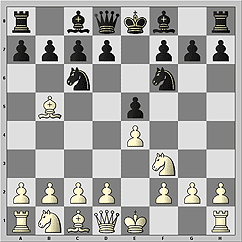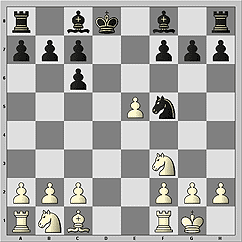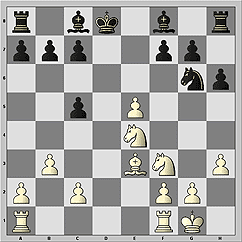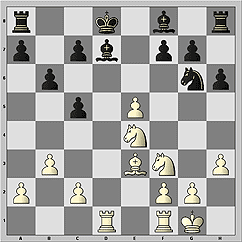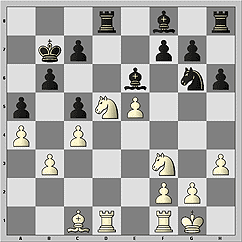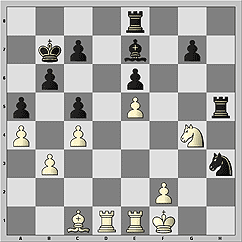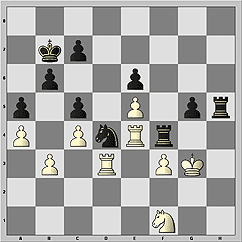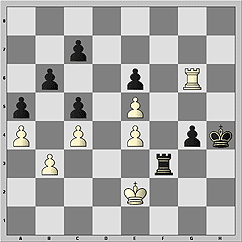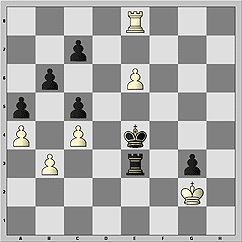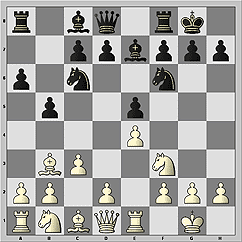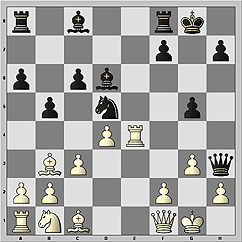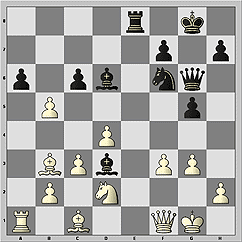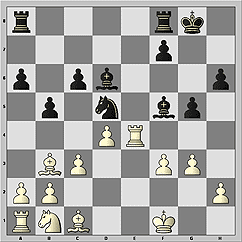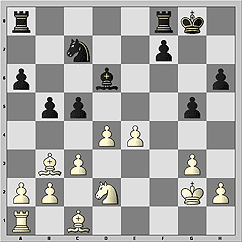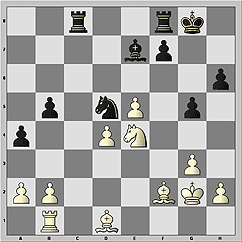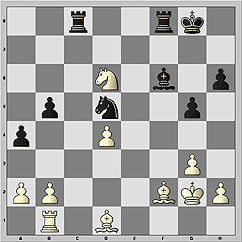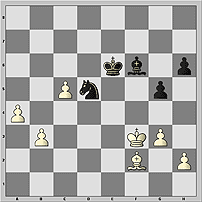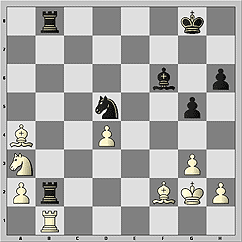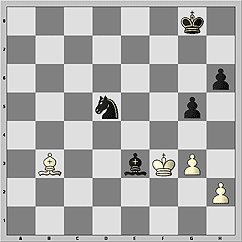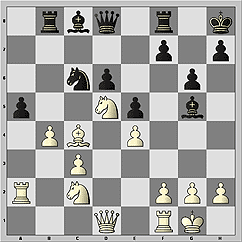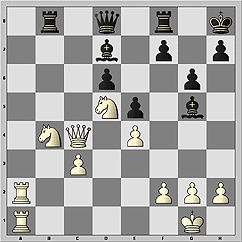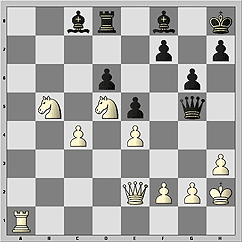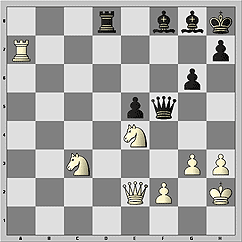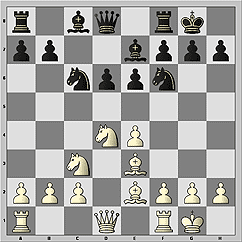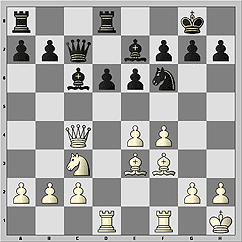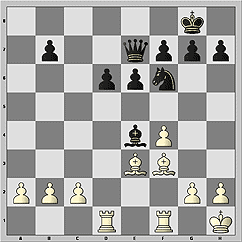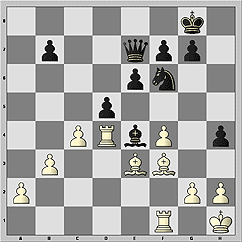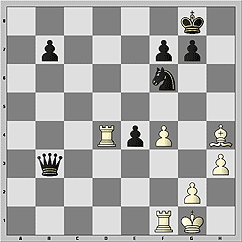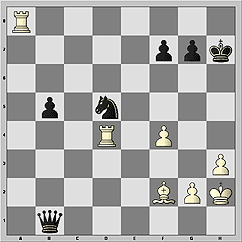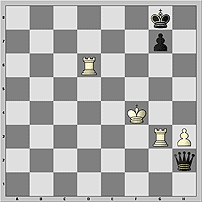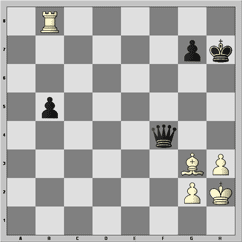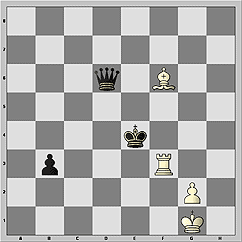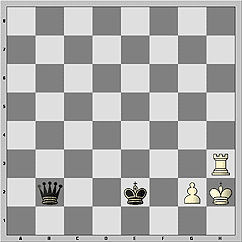 | Последние турниры |
Чемпионат России
СуперФинал

02.12.2006
Суперфинал чемпионата России проходит в Москве, в ЦДШ им. М.М.Ботвинника со 2 по 15 декабря при 12 участниках по круговой системе.
Крамник - Fritz

25.11.2006
С 25 ноября по 5 декабря в Бонне чемпион мира Владимир Крамник сыграет матч из 6 партий с программой Deep Fritz. В случае победы Крамник получит 1 миллион долларов, тем самым удвоив свой стартовый гонорар ($500000).
Мемориал Таля

5.11.2006
В Москве с 5 по 19 ноября проходил Мемориал Таля, в программе которого супертурнир 20-й категории и выдающийся по составу блицтурнир. Призовой фонд каждого состязания - 100.000 долларов.
Топалов - Крамник

23.09.2006
После того как "основное время" не выявило победителя (счет 6:6), 13 октября соперники сыграли 4 дополнительных поединка с укороченным контролем времени.
Томск. Высшая лига

2.09.2006
Со 2 по 11 сентября Томск принимает Высшую лигу чемпионата России 2006 года. В турнире участвуют 58 шахматистов - как получившие персональные приглашения, так и победившие в отборочных состязаниях.
Майнц

17.08.2006
В последние годы фестиваль в Майнце вслед за "Амбер-турниром" стал центром легких шахматных жанров. Наряду с массовыми ристалищами традиционно проходят чемпионские дуэли.
Россия - Китай

10.08.2006
С 10 по 20 августа в Китае проходит товарищеский матч сборных России и Китая. В нынешнем поединке как мужчины, так и женщины соревнуются на пяти досках по шевенингенской системе в два круга.
Все материалы
ChessPro

|
|

|
|
 |
Сергей ШИПОВ,
гроссмейстер |
Recital goes on! |
It goes beyond all the limits! Who could ever imagine before the event that one of the participants would be head and shoulders above the others? Moreover, many experts believed that the winner would be just first among equals and his victory would not be a solid basis for reigning in the world of chess. They were wrong…
Topalov demonstrated a phenomenal performance in the first six rounds. Actually, nobody have heart to tell that the Bulgarian was lucky; the opponents did play their best against him, etc. He fully deserved this amazing score! The two-point distance mirrors the real difference between the leader and his pursuers.
Having beaten Polgar in the sixth round, Veselin proved once again that he is a versatile all-round chess player. There were neither complications nor attacks in this game. The Bulgarian scored the full point in the positional fight thank to his fine touch and excellent technique.
Ruy Lopez C67
Judit POLGAR (HUN) – Veselin TOPALOV (BUL)
1.e4 e5! Black took a wise practical approach. It is much better to play solid positional chess against such a brilliant tactician as Judit. Everyone remember Kasiamdzhanov’s fate!
2.Nf3 Nc6 3.Bb5 Nf6. More than a century ago many masters played this way. The system was particularly popular among German chess players such as Adolf Anderssen, Zigbert Tarrasch and young Emmanuel Lasker, who lived in Berlin for some period of time. Thus, the line was called Berlin system. A century later after the Germany reunification, during the match Kasparov – Kramnik (2000) another name sprang up – Berlin wall! Indeed, the system did not enjoy a great deal of popularity in the second part of the last century. Only GM Alexandrov played it on regular basis in the 90s. Others GM used the Berlin as a weapon against particular opponent. Zoltan Almasi made a great contribution into the development of the system on the top level. Summing up, before 2000 just a few played the system, after Kramnik’s victory in the match everyone does!
4.0–0 Nxe4 5.d4 Nd6. Anderssen preferred 5...Be7. Nowadays this continuation brings about the – 6.Qe2 Nd6 7.Bxc6 dxc6 8.dxe5 Nf5 9.Rd1 Bd7 10.e6 fxe6 11.Ne5 – this is just the beguining of theory. Actually the ensuing game is in the spirit of XIX century.
6.Bxc6 dxc6 7.dxe5 Nf5 8.Qxd8+ Kxd8. This position became a real nightmare for Kasparov in the London match. He managed to break Kramnik’s defense a little bit later at the tournament in Astana (2001). However he had been already lost the match…
9.Nc3 Ne7! The classics of XIX century did not know this maneuver, introduced by Almasi. Black clears the way for his light-squared bishop and transfer the knight to g6 to attack the e5-pawn.
10.h3 Ng6 11.Ne4 h6 12.b3. The Bulgarian GM many times played this variation on the both sides. Check out the firework he made together with another chess pyrotechnic: 12.Re1 Be6 13.Nd4 Bd5 14.Nf5 Nxe5 15.Bf4 Nd7 16.Nc3 g6 17.Nd4 Bb4 18.Nxd5! Bxe1 19.Bxc7+ Kc8 20.Rxe1 cxd5 21.Bd6 a5 22.Re7 Ra6 23.Nb5 a4 24.Ba3 f6 25.Nc3 Ne5 26.Nxd5 Rd8 27.Ne3 Rc6 28.b3 axb3 29.axb3 Rd7 30.Re8+ Rd8 31.Re7 Rd7 and the opponents had to seal a draw. (Topalov – Shirov, Prague 2002).
12...c5. I should note that not always Black manage to counter White’s simple strategy. I mean the pawn attack on the kingside. For example 12...Ke8 13.Bb2 a5 14.a4 Nf4 15.Rfe1 Bb4 16.c3 Be7 17.Rad1 Ne6 18.c4 Bb4 19.Re3 Bd7 20.Nh4 Rd8 21.Nf5 Bc8 22.Rxd8+ Kxd8 23.Rd3+ Ke8 24.g4 Bf8 25.Bc1 b6 26.Nfg3 c5 27.Be3 Bb7 28.f4 and White gradually won. (Karjakin – Kramnik, Dortmund, blitz 2004)
13.Be3. Novelty. Actually, it is very difficult to come up with a new idea in this system. Correcting the move order is quite a different matter… I think White should develop the dark-squared bishop to b2. In this case White has more chances to launch operation on the kingside as the f3-knight is not tied to defense of the e5-pawn. A recent game of two top Ukrainian women was drawn after 13.Bb2 Be6 14.c4 Be7 15.Ng3 h5 16.Rad1+ Ke8 17.Bc1 h4 18.Ne4 Rh5 19.Rfe1 Rd8 20.Rxd8+ Kxd8 21.Nfg5 Bxg5 22.Bxg5+ Kc8 23.f4 b6 24.Rf1 Bd7 25.Kf2 Nf8 26.Ke3 Ne6 27.Rd1 Bc6 – the position is about equal (Lahno – Zhukova, Sochi 2005).
13...b6 14.Rad1+ Bd7. That is an interesting moment of the game.
15.Nc3. White could have advanced her pawn to h5 15.h4 Kc8 (15...h5? 16.Neg5!) 16.h5 Ne7 but what is next? Black plans to capture this pawn with the bishop. White does not what to place his knight to h2. Stopping the g2-pawn with the g3 knight does not look particularly appealing either.
15...Kc8 16.Nd5 Be6 17.c4 (that is a standard pawn arrangement in the system) 17...Kb7 18.Bc1 (White admitted to being in the wrong) 18...a5! 19.a4. White should not allow a5-a4. On the other hand the b3-pawn became a permanent weakness. Black can transfer his bishop to c2 in some lines.
19...Rd8.
20.g4? After this serious mistake White fall into troubles. Her attack at the queenside is absolutely unprepared. Actually, White has no advantage. Moreover, Judit had to play with accuracy to maintain balance.
20...h5! (the white hunters became the prey) 21.Ne3 Re8! (Black should avoid exchanges in this position) 22.Rfe1 Nf4 23.Ng5 Be7 24.Nxe6 fxe6. Now the h3 pawn inevitably falls.
25.gxh5 Nxh3+ 26.Kf1 Rxh5 27.Ng4. Black emerged with an extra pawn and incessant initiative. Judit mounted a stubborn resistance but failed to hold her position.
27...Bg5 28.Bxg5 Rxg5 29.f3 Rf8 30.Kg2 Nf4+ 31.Kg3 Rh5 32.Kf2 (32.Rh1 Ne2+ 33.Kf2 Rxh1 34.Rxh1 Nd4–+) 32...Ng6 33.Rd7 Rh3 34.Re3 Nh4 35.Rdd3 (35.Rxg7? Nf5–+) 35...Kc6 36.Rc3 Rh1 37.Red3 Nf5 38.Ne3 Nd4. The Black knight took up an ideal position. Both White’s weaknesses are under fire.
39.Nf1 Rh5 40.Re3 Rf4 41.Rcd3 g5 42.Re4 Kb7 43.Kg3.
43...Rxe4. Black had a shorter path to the victory: 43...Nxf3! 44.Rxf4 Nxe5 and White attempt to keep her extra piece with 45.Rff3 fails to 45...g4 46.Rfe3 Rh3+ 47.Kg2 Nxd3 48.Rxh3 gxh3+ 49.Kxh3 Kc6. This endgame is winning for Black.
44.fxe4 Rh4 45.Nd2 Kc8 46.Re3 Kd7 47.Re1 Ke7 48.Nf3! (the transposition into a rook endgame offers the best chance to escape) 48...Nxf3 49.Kxf3 Kf7. After 49...Rh3+ 50.Kg4 Rxb3 51.Rh1 White has a good counterplay.
50.Rd1 Rf4+ 51.Ke3 Kg7! 52.Rd7+ Rf7 53.Rd1 (naturally, White avoid rook exchange as the pawn ending is hopeless) 53...Kg6 54.Rd8 g4 55.Rg8+ Kh5 56.Rh8+ Kg5 57.Rg8+ Kh4 58.Rg6 Rf3+ 59.Ke2. One may think that Black gradually played it to a draw. However a fine maneuver by Topalov dispels this illusion.
59...Kg3! 60.Rxe6 Kf4! 61.Re8 Re3+ 62.Kf2 (the sequence 62.Kf1 Kxe4 63.e6 Kd3! 64.e7 Kc3 65.Kf2 Re4 is no better for White) 62...g3+ 63.Kg2 Kxe4 64.e6. At this point the jokers from ICC entered the move 64...Ke5? and displayed the result 0–1. This “joke” stirred up chess fans all around the world, as White can save the game after 65.Rg8! Did Judit resing in the drawing position?
The explanation is very simple. In reality Veselin played 64...Kd3! The black king is heading to the b3-pawn. White resign
Next encounter saw another important step to explore the most complicated variation of modern chess theory.
Ruy Lopez C89
Vishwanathan ANAND (IND) – Peter SVIDLER (RUS)
1.e4 e5 2.Nf3 Nc6 3.Bb5 a6 4.Ba4 Nf6 5.0–0 Be7 6.Re1 b5 7.Bb3 0–0 8.c3! It is always nice to see feisty guys who dare play the Marshall attack.
8...d5 9.exd5 Nxd5 10.Nxe5 Nxe5 11.Rxe5 c6 12.d4 Bd6 13.Re1 Qh4 14.g3 Qh3 15.Re4 (currently it is the main path for White) 15...g5 16.Qf1. This position has been in focus of all theorists before, in course and after the match Kramnik – Leko (2004). The verdict has not passed yet
16...Qxf1+. The fifth game of the above mentioned match saw 16...Qh5 17.Nd2 Bf5 18.f3 Nf6 19.Re1 (I think 19.a4 is more logical) 19...Rae8 20.Rxe8 Rxe8 21.a4 Qg6 22.axb5 Bd3
Here the error in preparation of Kramnik’s team (Peter was a member of this team) was revealed. Instead of repeating moves with 23.Qd1 Be2 24.Qc2 Bd3 25.Qd1 Kramnik and his assistants decided to push for a win with 23.Qf2? Re2 24.Qxe2 Bxe2 25.bxa6 – the white pawn is advancing to the eight rank. One may think that Black is in deep trouble, but Leko found 25...Qd3!! It turned out that Black had an irrefutable attack (Kramnik – Leko, Briissago 2004). Since Peter did follow Leko’s track, we can suppose that a better continuation was found for White.
17.Kxf1 Bf5 18.f3! (this exchange sacrifice is a typical maneuver in this variation) 18...h6.
19.Nd2! This novelty is unquestionably the most consistent and strong move. In the game Peng Xiaomin – Grischuk (Shanghai 2001) White sheepishly swerved from the warpath – 19.Re1 Rfe8 20.Bxd5 cxd5 21.Rxe8+ Rxe8 22.Kf2 a5 23.a3 Bd3 and the parties signed a piece.
19...Bxe4! (Black picked up the gauntlet) 20.fxe4 Nc7 21.Kg2. Vishy made this move very quickly. Most likely he discarded the variation 21.e5 Be7 22.Ne4 in view of 22...Nd5 and Black gets counterplay chipping away at the center with f7-f6!
21...c5! Peter also responded immediately. Starting from this point and up to 28th move that was only the Indian GM who thought on this position! Russian was coming back and making his moves without hesitations. It was really impressive! However, in my opinion, Black failed to completely equalize the position.
22.e5 Be7 23.Ne4 cxd4 24.cxd4 a5 25.Be3! Precise move. Opening new files does not favor White. That is exactly what happen in case of 25.a3 a4 26.Ba2 b4!
25...a4 26.Bd1 Nd5 (I think an immediate 26...f6 deserves a close consideration) 27.Bf2 Rac8 28.Rb1. This move is really hard to foresee in home preparation. Note the number of the move, it is 28th! Imagine how many lines every GM fighting on the top level has to keep in his mind! Besides, there is a throng of sub-variations and reasonable alternative on every move. One should be prepared for each and any of them. The exchange of blows is unacceptable for White – 28.Be2 Rc2 29.Bxb5 Ra8 30.Rb1 a3 and Black grabs advantage.
28...f6. That is the most conceptual continuation. Black should shatter White’s fortification in the center. On the other hand Black had another good option, namely, 28...Rfd8. It is very difficult for White to make progress. For example, 29.Be2 b4 (29...f5?! 30.Nc3! Nxc3 31.bxc3 Rxc3 32.Bxb5+/-) 30.Bd1 Nb6 (30...a3 31.Bb3!+=) 31.d5!? Nxd5 32.Bxa4 f5! 33.exf6 Nxf6 34.Re1 Kf8 and Black has nothing to complain about.
29.exf6 Bxf6 (inferior is 29...Nxf6 30.Nc3!) 30.Nd6.
30...Rc6. Peter seeks after trading pieces. He succeeded but in my opinion not without cooperation of his opponent. Probably better was 30...Rb8 and any White’s attempt to snatch the b5-pawn backfires: 31.Bf3 (31.Be2 Rb6! 32.Nxb5 Rfb8) 31...Ne7 32.Be2 Rb6! 33.Nxb5 Rfb8 and Black captures on b2. With this in mind, the continuation 31.Bf3 Ne7 32. Re1 or 32.b3 with a complicated position seems more logical.
31.Nxb5 Rb6. The sequence 31...Rb8 32.Bxa4 hardly makes any difference. White has some new options at the cost of others, but the evaluation remains the same.
32.Bxa4 Rfb8. After 32...Ra8 33.b3 Ra5 the best option is 34.Rc1 (not so clear is 34.Na3 Nc3 35.Rc1 Nxa4 36.Rc8+ Kf7 37.Nc4 Rd5) 34...Rbxb5 35.Bxb5 Rxb5 36.Rc5! Rxc5 37.dxc5 Kf7 38.Kf3 Ke6 39.a4
It is not that easy for Black to reach a draw in this position. In addition to advancing queenside pawns, White may launch active operation on the opposite wing…
33.Na3 Rxb2. That is the last interesting moment of the game.
34.Rxb2. It is hard to understand why Vishy made this move so quickly! He had enough time. It was worth calculating the line – 34.Bb3! Rxb1 35.Nxb1 Kg7 36.Kf3 and White can play for win running no risks. Supported by the king, the white pawns have a chance to advance.
34...Rxb2 35.Nc4 (now total exchanges are imminent) 35...Rxa2 36.Bb3 Rxf2+ 37.Kxf2 Bxd4+ 38.Ne3 Bxe3+ 39.Kf3.
Draw.
The opponents failed to complicate the issue in the next game. Their desire to play it safe was ineradicable…
Sicilian Defense, B33.
Rustam KASIMDZHANOV (UZB) – Peter LEKO (HUN)
1.e4 c5 2.Nf3 Nc6 3.d4 cxd4 4.Nxd4 Nf6 5.Nc3 e5. Leko opted for the Sveshnikov variation again. Apparently the opening failure in the game with Anand was not a great problem for him.
6.Ndb5 d6 7.Bg5 a6 8.Na3 b5 9.Nd5 Be7 10.Bxf6 Bxf6 11.c3 0–0 12.Nc2 Bg5 13.a4 bxa4 14.Rxa4 a5 15.Bc4 Rb8 16.Ra2 g6 17.0–0 Kh8 18.b4.
18...Bd7! (here comes the improvement; against Vishy Peter played 18...axb4 19.cxb4 Be6 but did not manage to equalize) 19.Qe2. That is a novelty. Black staged an exemplary play in the following game – 19.Qa1 Qc8 20.Bd3 axb4 21.Ba6 Qd8 22.Ncxb4 f5 23.exf5 gxf5 24.Nxc6 Bxc6 25.Nb4 Ba8 26.Rd1 f4 27.Bc4 f3 28.g3 e4 29.Nc2 Qf6 30.Re1 Bd2 31.Nd4 Bxe1 32.Qxe1
(д)
32...e3! 33.Qxe3 Bd5! and White resigns (De Firmian – Scandorff, Denmark 1997). That is how Black should play in this line. Active operation in the center evolved into a crushing attack at the white king.
19...axb4 20.Ncxb4. White is trying to squeeze through the eye of a needle. It is not the way to obtain a sizeable advantage. First of all White should analyze the move 20.cxb4!? – and the passer on the queenside might become White’s big trump.
20...Na5 21.Rfa1 Nxc4 22.Qxc4.
22...Rc8. The continuation 22...f5! striking up counterplay suggested itself. Black carried out this breakthrough only ten moves down the road.
23.Qe2 Rc5 (it is not that difficult to reconstruct Leko’s train of thoughts; after f7-f5 the d5-knight falls under attack) 24.Ra7. The seventh rank is a very promising direction of White’s activities.
24...Be6 25.h3 Bh6. Probably, initially Peter was planning 25...f5 but when the game came to this point realized that White could transfer his knight to the center with tempo by 26.Na6!? Most likely he figured out that White could take no heed of Black’s threats to his d5-knight: 26.exf5!? and the knight is immune – 26...Bxd5 27.Nxd5 Rxd5 in view of 28.fxg6 hxg6 29.Qe4!
26.Na6 Ra5 27.Nac7 Rxa1+ 28.Rxa1 Bc8 29.c4 (White’s knights dominates the board) 29...Qg5 30.Kh2 Rd8 31.Nb5 Bf8.
32.Qf3. Probably better was 32.Ra7! keeping Black in the corner. Indeed, 32...f5 fails to 33.f4! exf4? 34.Qb2+ Kg8 35.Nf6+ and Black loses his queen.
32...f5 33.Ra7 (now this move is nearly as efficient) 33...Be6 34.g3 fxe4 35.Nf6! Bg8! (fortunately, chess is not checkers. It is not mandatory to capture the opponent’s queen) 36.Nxe4 Qf5 37.Qe2 d5 38.cxd5 Bxd5 39.Nbc3 Bg8. The position get equalized once and for all.
40.h4 Bg7 41.Qe3 Rf8 42.Kg2 Qe6 43.Rc7. Draw.
All Morozevich’s games in this event are long, complicated, and double-sided. The problems is that I have time and energy to analyze them in depth. Unfortunately, my countryman can’t win a single game in San Luis. Neither can the best British GM. Obviously, the draw equally upset both fighters.
Sicilian Defense B 45
Michael ADAMS (ENG) – Alexander MOROZEVICH (RUS)
1.e4 c5 2.Nf3 e6 3.d4 cxd4 4.Nxd4 Nc6 5.Nc3 d6 6.Be3 Nf6 7.Be2 Be7 8.0–0 0–0. Sheveningen variation. Michael has been playing this system for many years, whereas Alexander is a rare guest there.
9.f4 Bd7 10.Kh1 (White could have kept the black bishop on d7 with 10.Nb3) 10...Nxd4 11.Qxd4 Bc6 12.Rad1 Qc7 13.Bf3 Rfd8. The opponents do without a7-a6 and a2-a4. On one hand, Black avoids loosening b6-square. On the other hand, White has some extra opportunities.
14.Qc4! Good maneuver. White is threatening with the knight’s thrust to b5.
14...Rac8 (Black has to leave his a7-pawn unprotected) 15.Nb5 Qd7. Novelty. I wonder whether the opponents studied this position before the game. After 15...Bxb5 16.Qxb5 a6 17.Qb6 Qxc2 18.Qxb7 Rb8 19.Qa7 Qxb2 20.Bd4 Qb7 21.e5 Nd5 22.Qxb7 Rxb7 23.f5 dxe5 24.Bxe5 Rb4 25.Rfe1 Kf8 White got initative for the pawn (Findlay – Taylor, Ottawa 1984).
16.Nxa7 Bd5. The exchange sacrifice is hardly sufficient for equalizing – 16...Bxe4 17.Nxc8 Rxc8 18.Qd4 Bxf3 19.Rxf3 Rxc2 20.Rf2 – White’s queenside pawns will have a decisive impact.
17.Qxc8. I think the following line leads to a roughly equal position – 17.Qe2 Bc4 18.Qf2 Bxf1 19.Nxc8 Rxc8 (19...Bxg2+ 20.Qxg2 Qxc8 21.e5 +/=) 20.Qxf1 (20.Rxf1 Qa4!) 20...Rxc2 (20...Qa4?! 21.c3 Qxa2 22.Qb5 +/-) 21.e5 Nd5! and so on.
17...Rxc8 18.Nxc8 Bxe4 19.Nxe7+ Qxe7. White emerged with two rooks for the queen. I think he is better here.
20.c4 h5! Starting from this moment Alexander skillfully maintains tension and poses various problems to his opponent. Michael failed to demonstrate his best game in the time trouble. As a result instead of converting his advantage he had to undergo a long and painful process of saving the game.
21.b3. If 21.Bxe4 Nxe4 22.f5 then 22...e5!; the variation 21.Bd4 Bxf3 22.gxf3!? looks too risky. In case of 22.Rxf3 Ne4 Black fortifies his knight in the center with f7-f5.
21...h4 (what to do with this brazen pawn? it really irks White as he has to recon with h4-h3...) 22.Rd4 d5. Black opens the position and starts incursion in White’s camp.
23.cxd5 (not so clear was 23.Bxe4 dxe4 24.Bf2 h3! 25.gxh3 Qa3 26.Rd2 Qa5 etc.) 23...exd5 24.h3 (just in case Michael fixates the pawn structure) 24...Qc7 25.Kh2 Qc3. The black queen is a blood-thirsty pirate who relentlessly attacks White’s pieces.
26.Bg1 Qc2 27.Bxe4 dxe4 28.Bf2 Qe2! (useful insertion) 29.Kg1 Qxa2 30.Bxh4. The sequence 30.b4 Qe2 31.Bxh4 Qe3+ 32.Bf2 Qxf4 33.Rd8+ Kh7 34.Bd4 Qc7 35.Bxf6 gxf6 brought no luck. White will have problems regaining the pawn.
30...Qxb3.
31.Kh2. White is trying his last chance to outplay Black’s corsair. After 31.Bxf6 Qe3+ 32.Kh1 gxf6 33.Rb4 Qe2 34.Rfb1 f5 35.Rxb7 Qf2 36.Re7 e3 37.Rbb7 Qf1+ 38.Kh2 Qxf4+ 39.Kh1 Qf1+ 40.Kh2 e2 41.Re8+ Kg7 42.Rbe7 draw is inevitable as Black delivers perpetual.
31...Nd5 (naturally Morozevich was also playing this position for win!) 32.Rxe4 Qd3 33.Rfe1 b5 (this pawn will be the main character in the second part of the game) 34.Bf2! Qd2 35.R1e2 Qd1 36.Ra2 Qb1 37.Ra8+ Kh7 38.Rd4.
38...Nc7! (good knight’s transfer) 39.Rb8?! This move incurs problems. White had some practical winning chances after 39.Ra7 Ne6 40.Rxf7! (absolutely harmless is 40.Rdd7 Qf1! 41.Be3 Nxf4=). It looks like Black should turn down this exchange sacrifice. Better is 40...Qa2 41.Rd6 (the line и 41.Re4!? Ng5 42.Rxg7+ Kxg7 43.Bd4+ Kg6 44.fxg5 also should be analyzed) 41...Kg8 42.Rf5 (42.Re7 Nxf4 43.Rdd7 Qxf2 44.Rxg7+ Kh8=) 42...Qc2 43.Rxb5 Nxf4 44.Kg3 Qe4 – it is really hard to finish this variation. Let me just prolong it – 45.Rb3 Qxg2+ 46.Kxf4 Qxf2+ 47.Rf3 Qh2+ 48.Rg3
And here it is OK to announce a draw.
39...Ne6 40.Rd7 Nxf4 41.Rxf7 Qe4! (Black is first to create serious threats) 42.Rxf4 Qxf4+ 43.Bg3. Is it possible to win this position on the black side? In order to do so, Alexander has to trade his b-pawn for the white rook. However, it looks like Black can’t cut off the white bishop from this pawn.
43...Qg5 (43...Qc4 44.Rb7 b4 45.Be5 Qd5 46.Rxg7+ Kh6 47.Re7=) 44.Re8! b4 45.Re2 b3 46.Be5 Qh5. What can I tell about the position arising after 46...Qe7 47.Kg1 b2 48.Rxb2 Qxe5? It is a dead draw! White has no problems holding this position. Try to explain it to computer…
47.Re3 Qd1 48.Rg3 Qd5 49.Bxg7 Qd6 50.Bb2 Kh6. To get rid of this pin White has to return the loot (i.e. the pawn).
51.h4 Kh5 52.Kh3 Qe6+ 53.Kh2 Kxh4 54.Rh3+ Kg4 55.Rg3+ Kf5 56.Rf3+ Ke4 57.Kg1 Qd6 58.Bf6. The rest requires no explanations. White’s fortress is indestructible.
58...Qd1+ 59.Kh2 Kd5 60.Bb2 Qc2 61.Bf6 Kc4 62.Kg1 Kb4 63.Rf4+ Ka3 64.Rf3 Qc5+ 65.Kh2 Qc1 66.Be7+ Ka2 67.Bf6 Qd1 68.Rf2+ Kb1 69.Rf3 Qd6+ 70.Kg1 Qb6+ 71.Kh1 Kc2 72.Rc3+ Kd2 73.Rf3 Ke2 74.Kh2 b2 75.Bxb2 Qxb2 76.Rh3.
76...Qe5+. Draw.
Standings after sixth round: 1. Topalov – 5.5 (Topalov’s fans more and more often brings up the victory he missed in the game with Anand); 2–3. Svidler and Anand – 3.5 (Peter and Vishy should forget about the leader, its to depressing to think about his performance; they would rather concentrate on their own games and close their eyes on the tournament standings); 4. Kasimdzhanov – 3 (Rustam is next in the line against the Bulgarian puncher; let’s wish him to avoid knock-out…); 5. Leko – 2,5 (Fans are tired of waiting Peter among the leaders); 6–8. Polgar, Adams, Morozevich – 2 (it is nice to be in such a cozy little gathering!)
|
|

